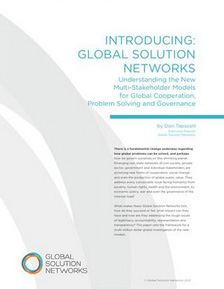I mentioned in an earlier post that Davos can be a catalyst for great ideas, and one example is the GreenXchange conceived by Nike. Nike formally launched the Xchange Wednesday morning at a CEO breakfast in Davos.
The venue was a conscripted hairdressing salon that was pressed into service by the Forum as a meeting space. We were like sardines. But the energy in the tiny room was high.
To recap: The Xchange is a Web-based marketplace where companies can collaborate and share intellectual property which can lead to new sustainability business models and innovation. Ten organizations have already signed on. The Xchange is the first step in a journey towards more sustainable innovation, and the more companies that get on board, the faster we’ll all make progress. More info can be found here. http://greenxchange.force.com/
In Wikinomics my co-author Anthony Williams and I argued that we’re living in a world where new approaches to collaboration enable new business models that enable companies to create better value for consumers. We said companies need a portfolio of intellectual property – some that they own and protect, some that they licence and some that they share. The green Exchange is all about achieving that.
Nike began the announcement with a cool video that made it clear that sustainability is not an obligation, it’s an opportunity. Companies can choose to be ahead of the curve or behind the times. The goal is to create an innovation community. No one is “giving away” their intellectual property; the exchange includes a licensing protocol.
“Nike is today committing to placing more than 400 of our patents on GX for research, demonstrating our belief that the best way to stimulate sustainable innovation is through open innovation,” said Mark Parker, Nike president and CEO. “Our hope is this will unleash new innovation to help solve current obstacles to sustainability issues.”
Example: Possible cross-industry benefits of making available Nike’s Environmentally Preferred Rubber. Used in Nike footwear the rubber contains 96 percent fewer toxins than the original formulation. By licensing the technology on GX it could be used in other company’s footwear, or it could hypothetically be used by Mountain Equipment Co-op for bicycle inner tubes. In this way Mountain Equipment Co-op could bring a greener product to market more quickly and cheaply than it could on its own.
Parker explained that initially the company’s lawyers opposed the Xchange. They felt intellectual property was always meant to be kept under wraps and guarded. But they’ve all come around to see the value of the Xchange, not only to the environment, but also bring competitive advantage to the company. When Nike’s patents are put into the commons, any improvements made to the patents will be available to Nike.
Parker said universities are a great source of intellectual property. What is needed – and what the Xchange provides – is a standard protocol whereby IP can bust out from the university and be helpful more broadly to business and society.
John Wilbanks, VP for Science at Creative Commons, said “There is so much duplication of effort and wasted resources when it comes to sustainability. We need to make it easier for individuals, companies, academia, and researchers to collaborate and share best practices.”
This idea of a patent commons came up at another session. Currently the planet has many commons like the ocean, air and space. Much of the Web is in the commons. It’s time we added an additional area: know-how related to sustainability.






I just read your comment about the general feeling toward Mr. Harper and his address in Davos. How would you have responded if you did not agree with the world view on climate change? I am assuming that as a well known writer that you may have doubts as to the validity of climate change. I think Mr. Harper is being very pragmatic in challenging the climate change philosophies and going directly to the economic cost of that philosphy. I think that with more questioning of the authenticity of the climate change information that maybe your point of view might change as it has mine. In any event I enjoy reading your commentaries.